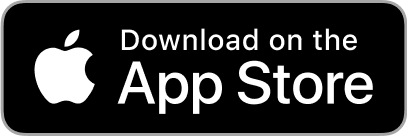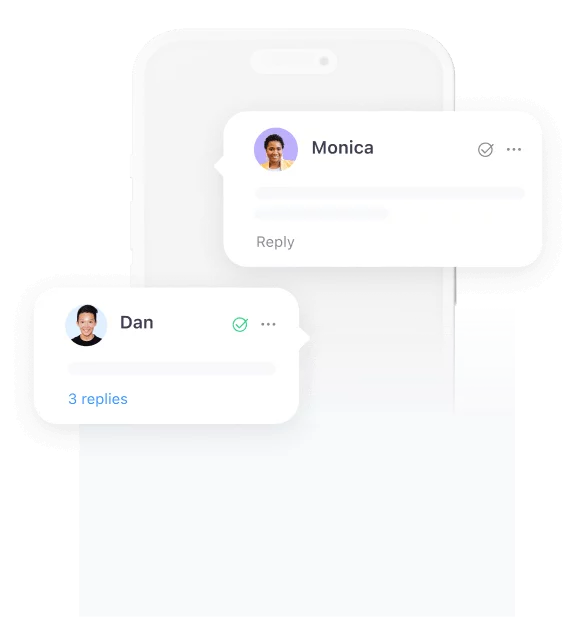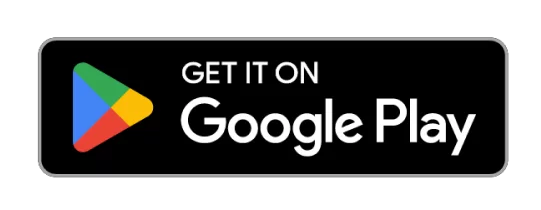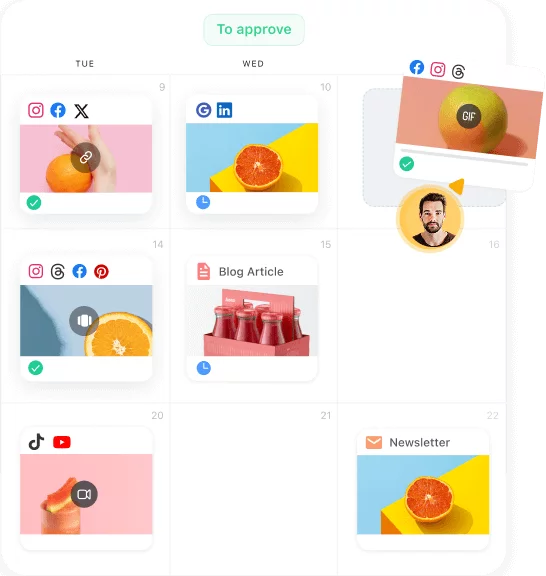For years, marketers fed the Content Monster with nonstop posts. Big names said volume won, so we treated visibility like a numbers game. That playbook’s outdated. Engagement now hinges on quality and clear relevance. According to the GWI study for the Financial...
How to plan your email marketing calendar (+3 tools to use)
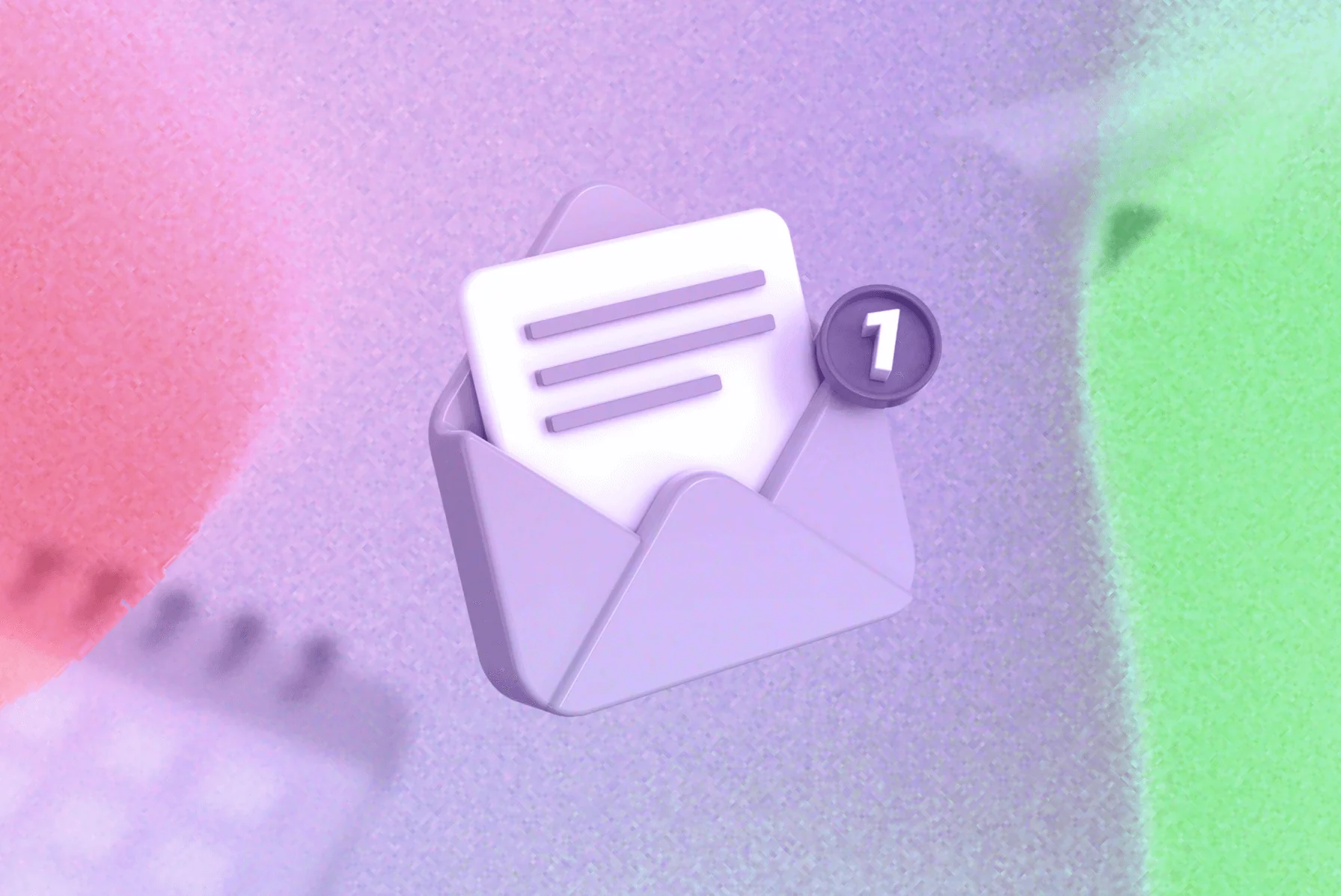
Any marketer worth their salt knows a well-planned email marketing calendar is key to executing strategy and getting successful marketing campaigns off the ground. Integrating email into your wider content calendar helps you gain a unified view of your efforts and keep messaging consistent over time. Instead of mismatched efforts and messy folders, you get a single streamlined view that generates useful insights.
Below, I’m going to detail how using a calendar helps keep your email marketing organized, and I’ll also shine a spotlight on three tools that simplify the process.
What is an email marketing calendar?
An email marketing calendar maps out all the emails you send out to your target audience. It can include seasonal campaigns, quick promos, and newsletters you send year-round. The calendar covers a set period and details each email campaign’s schedule, content, and target audience.
Why marketing teams and agencies use email marketing calendars
A solid email calendar is one of the most useful marketing agency tools. It helps keep business goals on track and proves how each email contributes to the larger vision. Here are five reasons to use one:
- Reason 1 – Executing a content marketing strategy depends on having a well-thought-out calendar that your team can use as a home base
Clear deadlines and roles free you up to focus on the right kind of emails (to your target audience, not to colleagues, chasing down info that could’ve been included in the calendar).
- Reason 2 – You can calibrate the email marketing frequency as you get to know various segments of your audience over time
Adjusting the scheduling during a live campaign is also a cinch, helping you stay flexible and get the results you want.
- Reason 3 – Campaign management goes to the next level with a sound email marketing calendar
You can look beyond the impact of singular tactics and see how every marketing campaign creates texture for your brand universe.
- Reason 4 – Content gaps become easy to spot when you use an email calendar.
This doesn’t just include times of the year when there isn’t much planned, but also brand pillars that haven’t been explored, unused formats, or audience segments that haven’t received an email campaign in a while.
- Reason 5 – It’s so much simpler to optimize your approach with good analytics
It’s so much simpler to optimize your approach with good analytics. You’re gathering info no one else has, including how your specific audience reacts to the behavior of your specific brand. Future email marketing decisions become easier to justify.
Email marketing calendar template
Planable’s email marketing calendar template is a straightforward yet powerful tool for organizing and tracking your email campaigns. It helps you plan out which emails go to which audience, keep track of key dates, and easily adjust things on the fly with its drag-and-drop interface. Plus, with color-coded labels, you can quickly categorize campaigns by audience, topic, or status for an at-a-glance overview.
Best of all, the template is flexible, so you can customize it to fit your team’s specific needs and keep everything aligned with your marketing goals.
How to plan a calendar for your email marketing strategy
Now that we’ve established its essential role in helping you stick to deadlines and do solid brand-building, let’s look at the actual steps of putting an email marketing calendar to good use. With a sound email calendar, every piece of content your marketing team works on can shine, whether you build a whole email campaign around it or let it spark a clever flash promo.
Step 1. Document how you will use the email marketing calendar
Work backward from your goals. Pare down larger marketing objectives into specific goals for the calendar itself, and you’ll find the sweet spot — no unnecessary detail to slow your team down but no important info missing right before a deadline either.
Do you want all your content initiatives in one place, with email marketing as just one feather in your cap? Or do you want to focus on email only, from strategic campaigns to long-running newsletters? If project management and task tracking are your priorities, you’ll set up your email marketing calendar with a different level of detail than someone who simply wants to have all social media posts and emails in one place.
Document goals and processes from the beginning, consider input from the people executing the strategy and keep everything easily accessible. Your specific style of creative project management should be reflected in the features you choose and the type of info you include. This makes picking the right email marketing tools much simpler.
Step 2. Choose the right email marketing calendar tool
Once you know what the calendar needs to accomplish, a loose list of preferred features will guide your choice of tool.
If your email marketing calendar needs to focus on content planning and creation, look for a platform with a friendly UI, robust collaboration and approval features, plus a media library that everyone has access to, for every workspace. If you’re more inclined towards task tracking, check out project management tools that come with Kanban board views and streamlined resource allocation.
Also look into what features different scheduling tools offer for contact management, such as audience segmentation, great email templates, or automation capabilities.
Step 3. Involve stakeholders in content curation
It’s worth creating a dedicated, laidback space where stakeholders can pitch in when it comes to content creation and ideation. A steady stream of inspo eases part of the pressure that comes with newsletter planning.
But with content curation, it’s about way more than quantity. When you visualize your ideal email calendar content and consider stakeholders to include, don’t just go by “cultural fit”. Instead, go by cultural contribution. Who can contribute perspectives that don’t always get included? This lens will keep your content fresh, grounded, and empathetic.
Choose the place that would best help cultivate a welcoming vibe. Could be a Slack channel, a dedicated workspace, or a good ol’ email thread where people drop funny and relevant links. What matters most is that everyone’s aware of the brand guidelines, but also comfortable enough to share even when unsure.
Suppose you’re collaborating with clients or external stakeholders. In that case, it can also help to introduce modern client communication tools that organize requests, approvals, and content feedback in one place instead of burying them in endless email chains.
Step 4. Decide your email frequency
When you plan content distribution, you consider the appropriate frequency for each channel and audience, so of course email marketing is no different. It takes time to pin down what it means for your specific email subscribers to be kept engaged but not annoyed. You could even consider letting them choose the frequency they’re comfortable with from a preference center.
Next, since testing is key, you’ll likely run A/B test campaigns that deliver emails with different frequencies to separate audience segments. Using an email marketing calendar with drag-and-drop functionality as opposed to a spreadsheet makes it easier to map out content for each version. This also applies to situations when you’re tweaking ongoing campaigns based on fresh insights.
Use demographic, psychographic, and behavioral data to create clever segmentations. When frequency-related decisions are rooted in the rhythms of people’s daily lives, you can absolutely see it reflected in the analytics.
Step 5. Note important dates and events in the calendar
The best email marketing calendars make chaotic periods more predictable for everyone involved. Consider your experiences with previous busy seasons and how a bit of automation in the right place could smooth out parts of the process.
Ideally, your list of important dates, times, and events should include two layers: milestones that relate to your brand (campaign phases, product launches, flash sales, etc,) plus relevant seasonal events in the world at large. When these layers sync up, you protect your brand’s reputation from tone-deaf emails (can’t delete a newsletter once it’s out!) and integrate your brand story into narratives people are already thinking about.
Once your dates are set, you can use an email marketing calendar tool with automated notifications to send out custom reminders in advance.
Step 6. Add content and campaign ideas to the calendar
The time has come. You’ve considered all the moving parts and structured the email calendar to your liking. You can now plan ahead for all your email content, including campaigns and regular newsletters.
A good email calendar will have custom labels and filters to help you connect each idea on the calendar to your email marketing strategy. This way, you can track how well brand pillars are executed and spot content gaps a mile away.
Since this is one of the most creative parts of the whole process, content collaboration features will also come in handy. Real-time feedback, suggestions, and annotations help you iterate on ideas until they are ready, while activity history keeps all alterations reversible. Look out for approval features, too: custom approvals for each workspace do wonders for efficient scheduling, not to mention links that are easily shared with clients or stakeholders.
3 best email marketing calendar tools
Creating an email marketing calendar is so much easier when you don’t start from scratch. These three tools work for email marketers with different-sized teams, but they all help with target audience segmentation and email planning. Here we go:
1. Planable – best marketing calendar tool for content planning, collaboration, and approval
Planable is a content marketing platform that makes it easy to collaborate on, plan, and approve all sorts of written content, from social media posts, blogs and press releases to emails and ebooks.
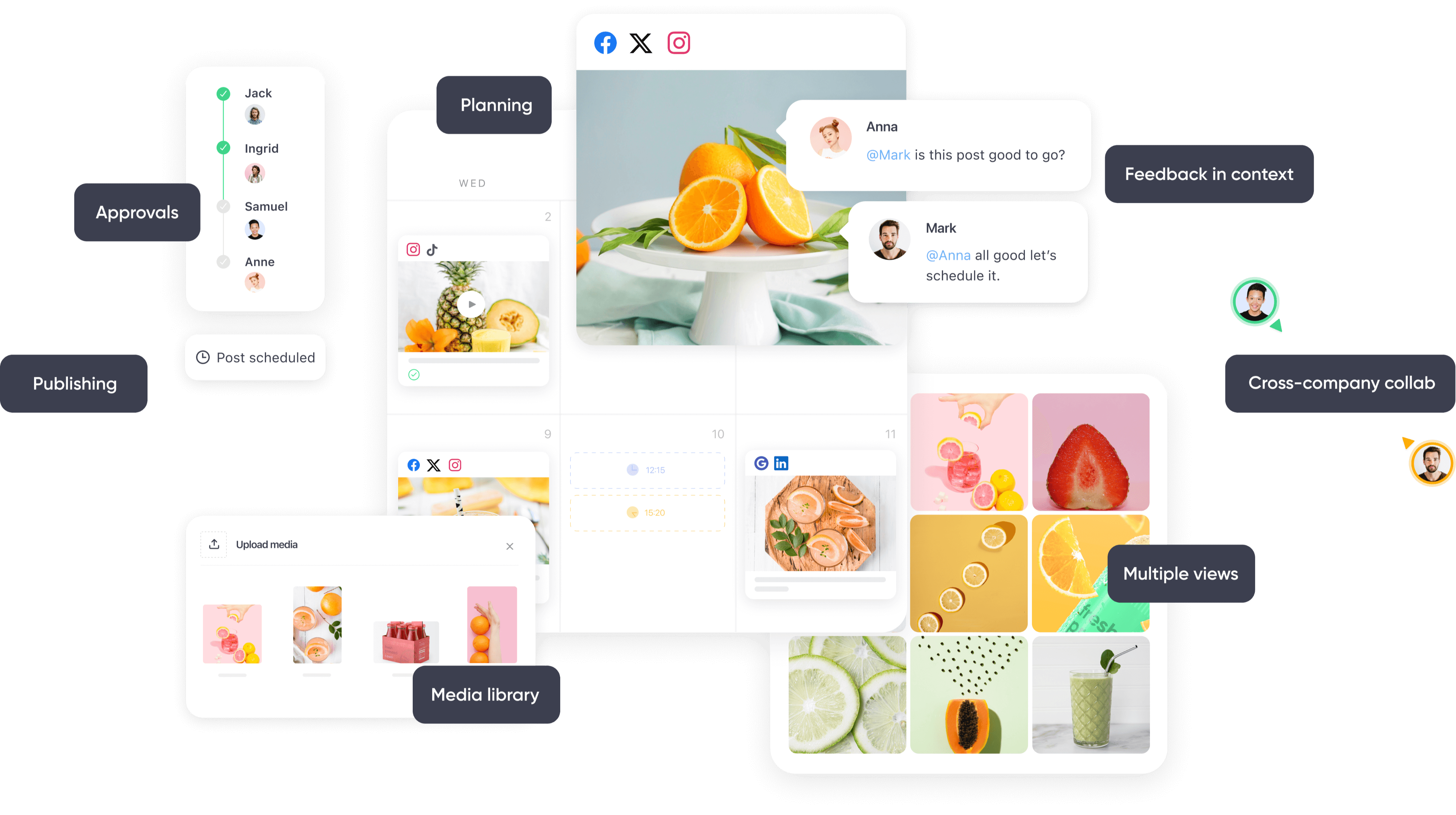
Planable features
Planable’s marketing calendar is one of its standout features, ideal for planning out your email sequences but also for looking at how they fit into your larger content marketing strategy. With newsletters, social posts, and other written content in one place, you get a better feel of your audience’s full experience.
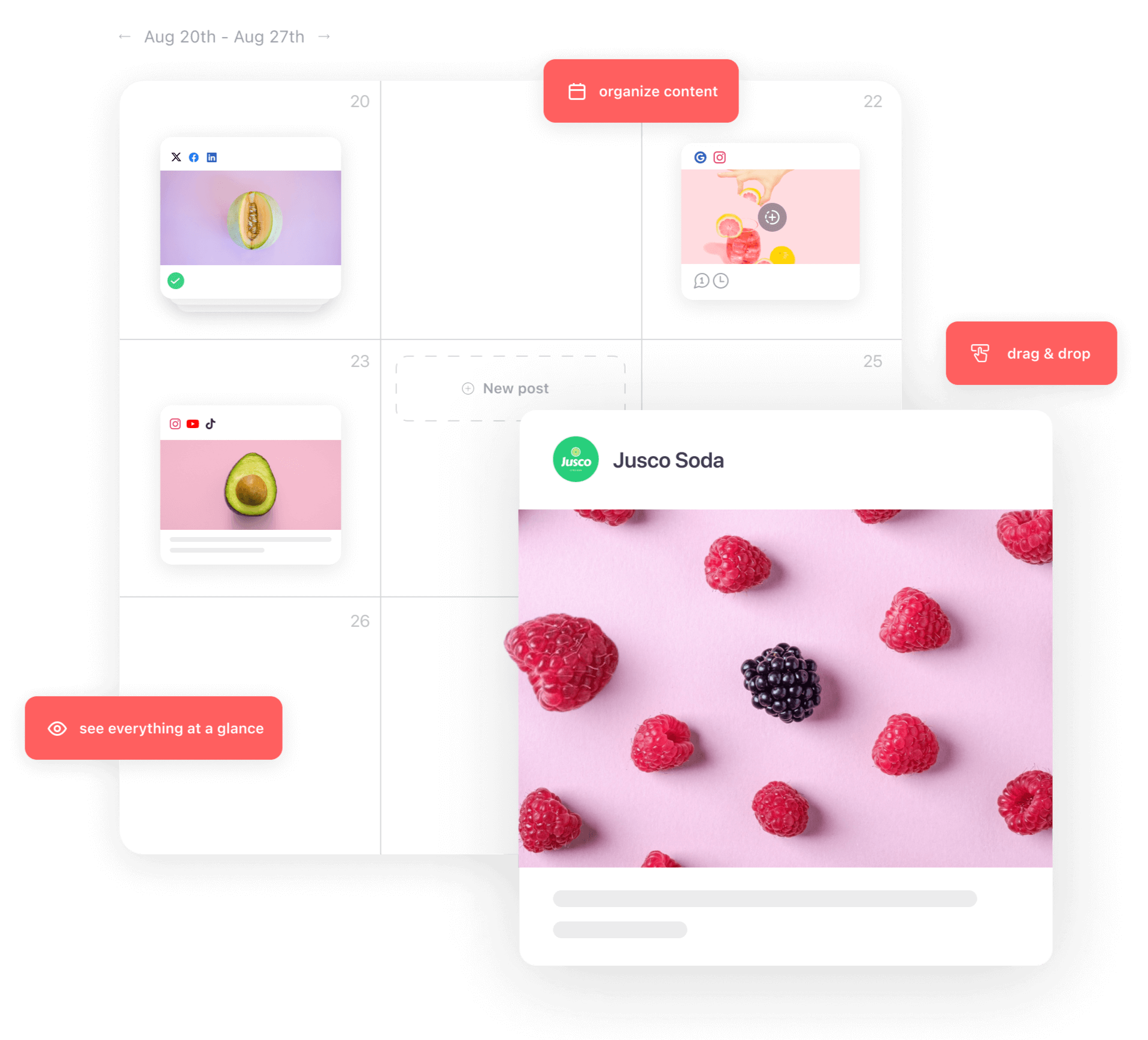
Content calendar with drag and drop in Planable
Everything you see can be filtered by status, period, or author, but you can also switch views entirely (calendar, feed, grid, or list). On top of this, you can add color-coded labels for specific campaigns or audience segments, as well as approve promotional emails straight from the calendar.
Updating your brand’s socials is also covered – you can use Planable to schedule social media posts for Facebook, Instagram, Threads, X, LinkedIn, TikTok, YouTube, Pinterest, and Google My Business.
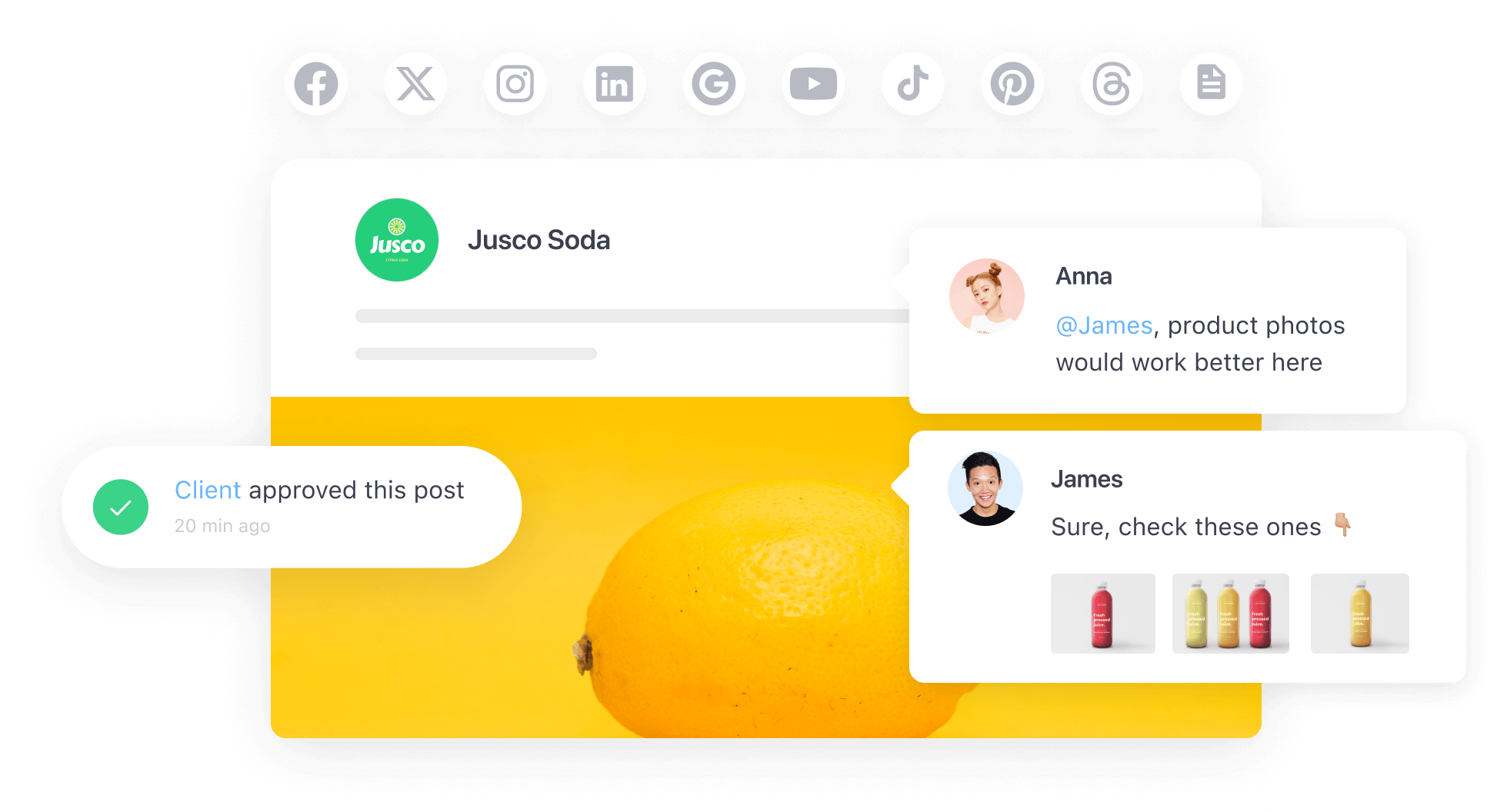
Collaboration and approval in Planable
One feature I’m sure agencies will love is the separation of distinct workspaces. Work for each client can have its own place, complete with customizable user permissions and approval settings.
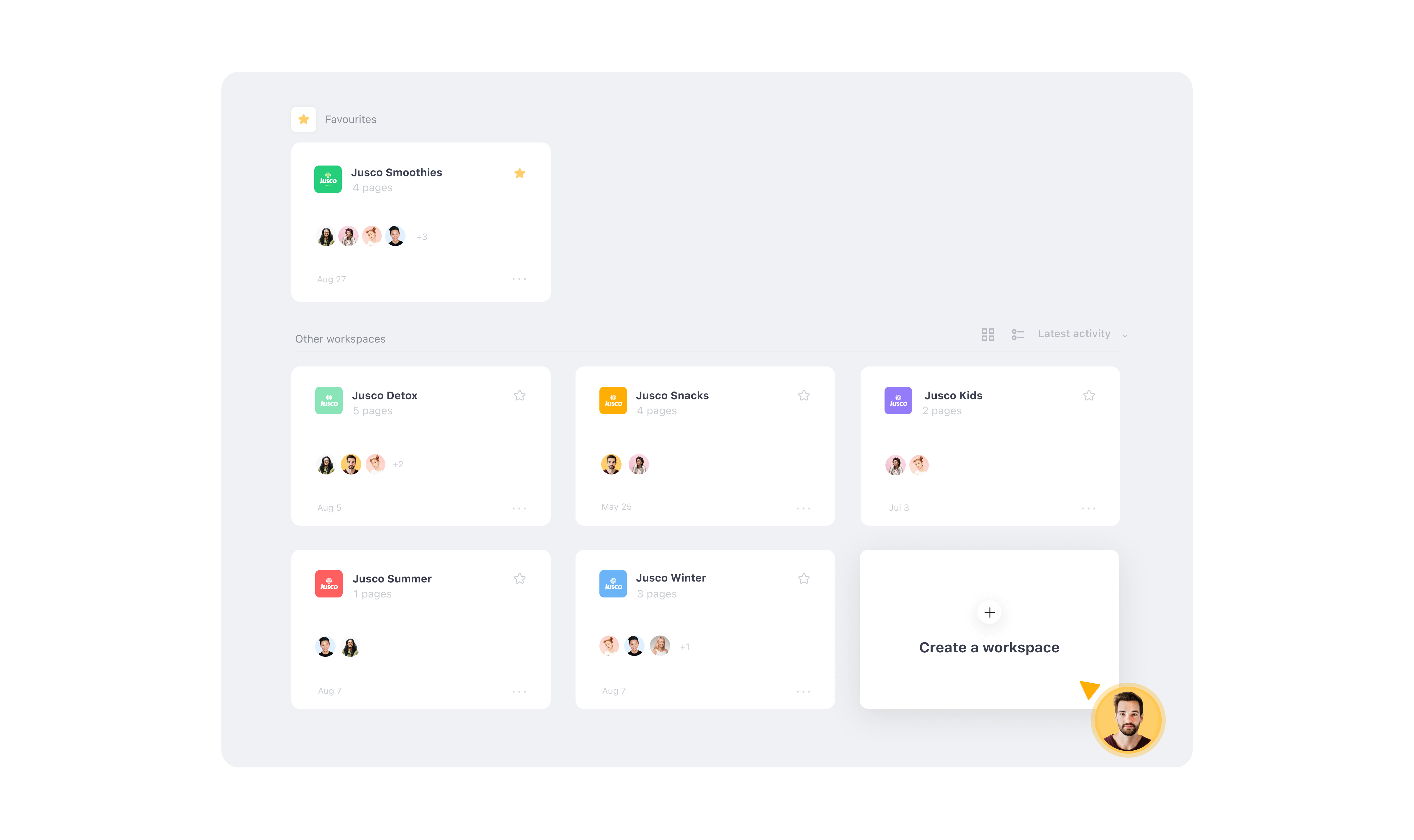
Distinct workspaces for brands or clients in Planable
For example, in each workspace, you can choose between four types of approvals: none, optional, mandatory, and multi-level. This last option is particularly useful when your team needs to give internal approval before the client gives the final green light to an email campaign.
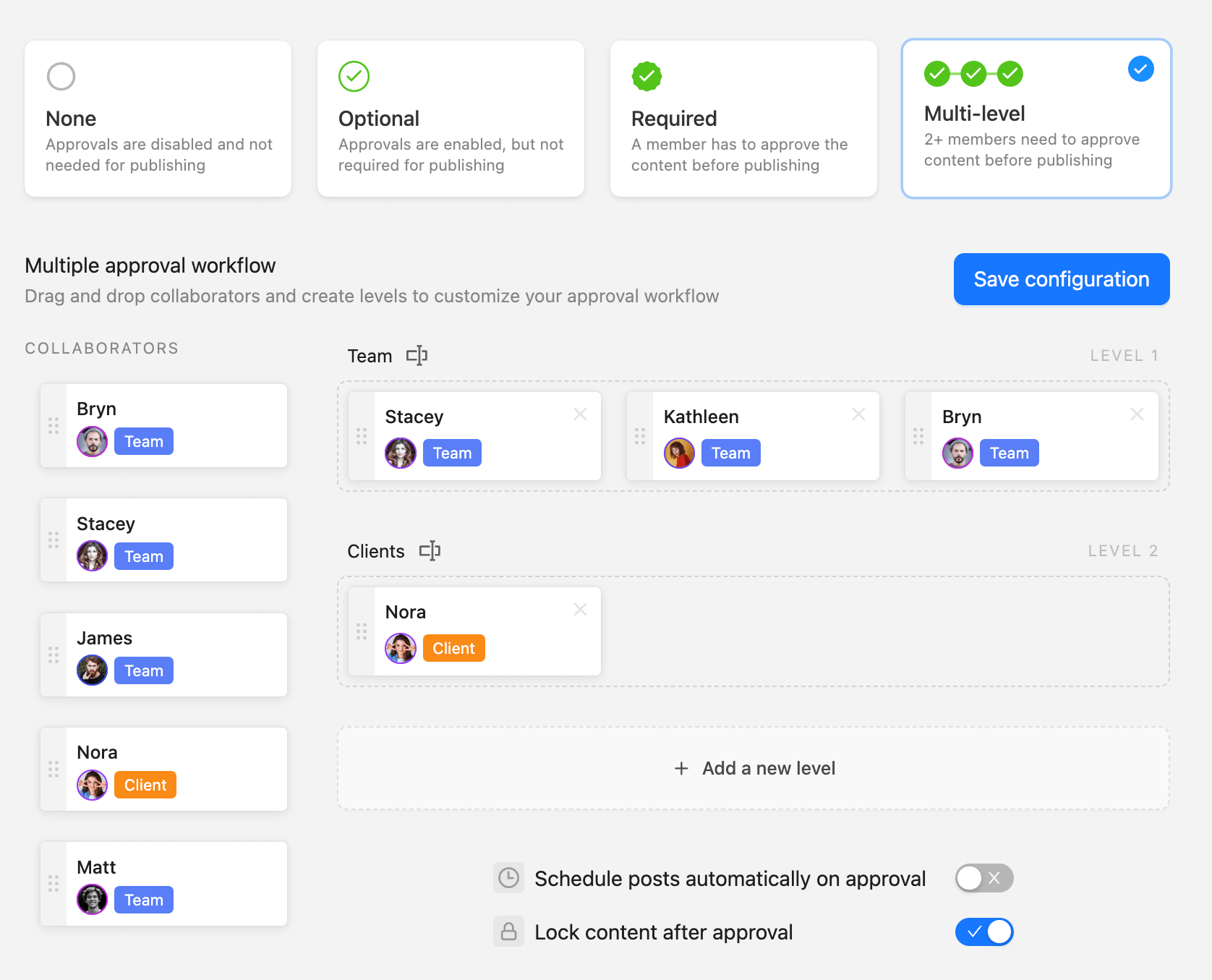
Multi-level approval workflow in Planable
Key features
- Calendar – keep written content and social posts organized and reschedule with only a drag-and-drop.
- Universal content – unlocks Planable for all types of written content and includes rich-text capabilities (headings, bullet points, hyperlinks, formatting, etc.).
- Collaboration – easily share clear, in-context feedback through comments, annotations, and text suggestions, plus custom roles and permissions for everyone.
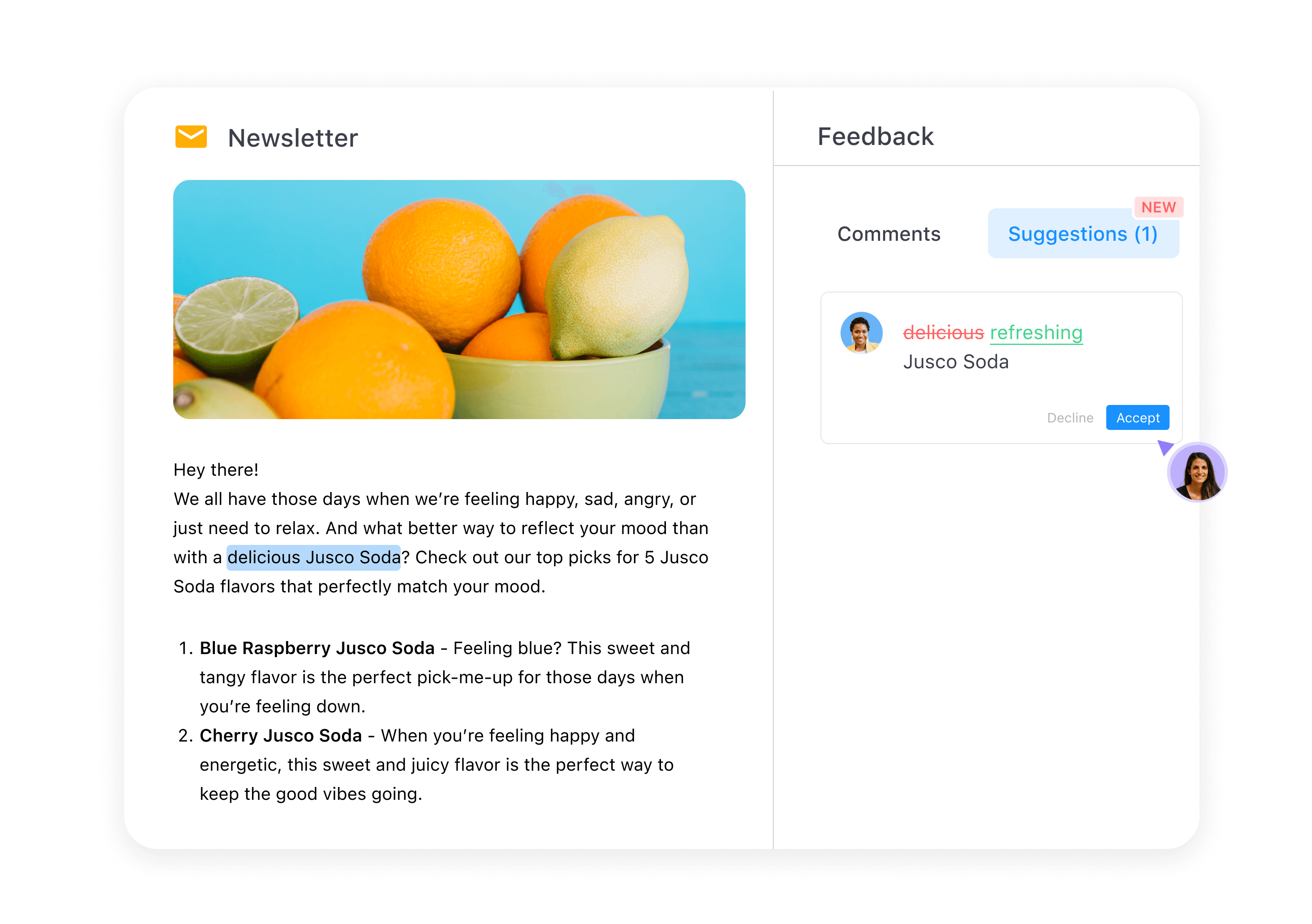
Collaboration on a newsletter draft in Planable UC
- Approvals – create custom approval workflows, but also share links to content with external collaborators.
Drawbacks: Planable is perfect for planning, creating, collaborating on, and approving email content, but scheduling emails is not supported yet.
Pricing: There’s a completely free plan that lets you use all the features for up to 50 posts. After that, plans start at $33/mo.
2. Google Sheets – best free tool for basic planning
When it comes to email marketing campaigns, Google Sheets is a simple tool, best used by those planning out an email calendar for the first time. While you can’t send emails directly or collaborate on long-form content, you can map out email sequences in the same place that holds your contact data.
Plenty of people already know how to use it, so while there are lots of lesser-known features, things are fairly straightforward (especially for those already comfortable using Excel). You’re also bound to find a good email marketing calendar template that you can open with Sheets to get started right away.
Key features
- Limited editing on certain cells – ensures that when multiple people are working on a Sheet, mistakes don’t end up being permanent.
- ImportHTML – lets you import almost any data you’d like to have in spreadsheet form, including contact lists and calendars.
- Filters – let you focus on, say, content for particular email marketing campaigns or follow-up email sequences.
Drawbacks: While useful for planning, Google Sheets wasn’t made to hold all the content you work with or empower a marketing team to collaborate on this content in-app.
Pricing: Google Sheets is free. When using it in a business setting, together with other tools in Google Workspace, tiers start at $6/mo.
3. Constant Contact – best email marketing calendar tool for scheduling and analytics
Constant Contact is an email marketing platform that lets users set up, schedule, and track email campaigns. It comes with a template library as well as tools for SMS marketing and plenty of integrations. It’s designed for marketers of all stripes, including everyone from freelancers to marketing managers in large organizations.
Key features
- List-building tools – create, organize, and segment contact lists to turn more website visitors into leads and then customers.
- Event marketing capabilities – these features cover everything from custom landing pages to ticket sales and reports.
- E-commerce tools – these tools connect to shopping platforms, targeting buyers with precision and increasing ROI.
Drawbacks: Automation capabilities for email marketing are limited compared to what other tools offer.
Pricing: Constant Contact comes with a 14-day free trial, then plans begin at $12/mo.
Here’s how to write a newsletter from scratch to inform, engage, and inspire your audience.
Plan your email marketing campaigns with a structured calendar
A successful email marketing strategy must include a content calendar. It’ll help you have a clear overview, use your team’s resources wisely, and reach people in a way they resonate with. Planable lets you plan all your email marketing campaigns and social media posts from a single calendar, with 50 posts for free at sign-up.

Irina is a freelance conceptual copywriter with an ethical edge and an advertising agency background. If she’s not rummaging for good synonyms, she’s probably watching a sitcom or listening to radio dramas with plucky amateur detectives. She loves collage, doing crosswords on paper and shazamming the birds outside her window.
